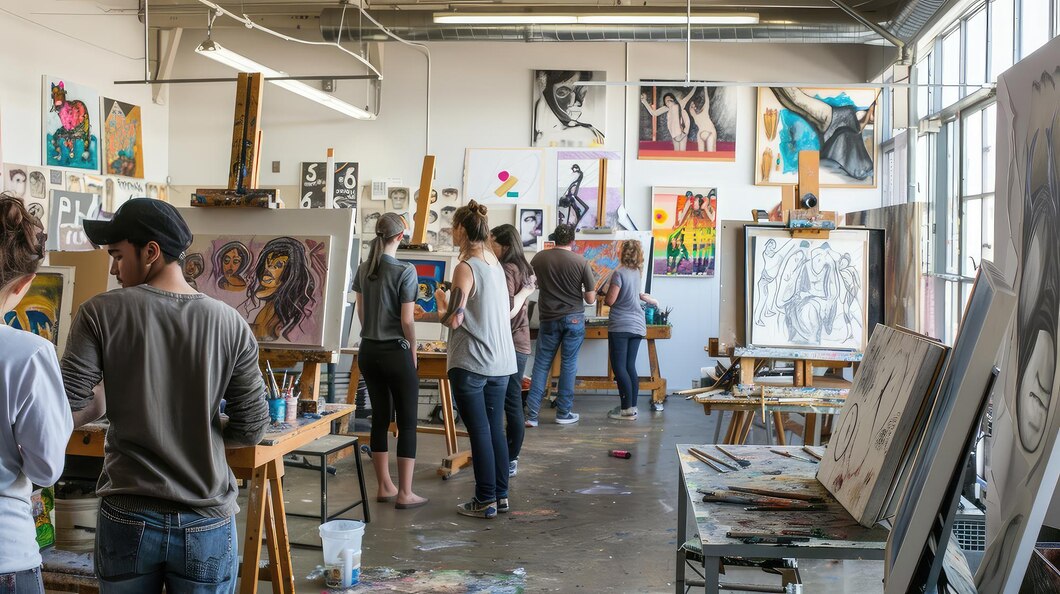Introduction
Fine arts represent a vast and diverse creative expression field encompassing visual, performing, and literary arts. The term “fine arts” traditionally refers to art forms developed primarily for their aesthetic value and beauty, as opposed to functional or practical purposes. This includes disciplines such as painting, sculpture, drawing, printmaking, photography, music, dance, theatre, and literature. Each discipline provides unique avenues for artists to explore and communicate their ideas, emotions, and experiences.
Visual arts include mediums like painting and sculpture, where artists use various materials and techniques to create tangible works that can be seen and touched. These artworks often serve as visual representations of the artist’s vision and can range from realistic portrayals to abstract compositions. Photography and printmaking are also part of the visual arts, focusing on capturing images and creating multiple copies of a single design.
Performing arts encompasses disciplines such as music, dance, and theatre, which involve live performances in front of an audience. Music combines sound and silence to create compositions that evoke emotions and tell stories. Dance uses the human body in motion to express artistic ideas and convey emotions through rhythm and movement. Theatre combines acting, dialogue, and visual elements to present stories and themes that reflect human experiences and societal issues.
Literary arts include poetry, prose, and drama, focusing on the written word as a medium of expression. Poetry uses rhythm, meter, and metaphor to create evocative and often emotionally charged works.
The importance of fine arts extends beyond mere aesthetic appreciation. Fine arts play a crucial role in personal development, fostering creativity, critical thinking, and emotional intelligence. They serve as a means of cultural expression, preserving and promoting heritage and traditions. Fine arts also have significant social and economic impacts, generating employment, tourism, and community engagement. They provide a platform for addressing social issues, inspiring change, and promoting diversity and inclusivity.
What is BFA?
A Bachelor of Fine Arts (BFA) is an undergraduate degree program offering specialized education and training in various fields of fine arts. Typically spanning four years, BFA programs combine theoretical study with practical application to develop students’ artistic skills and knowledge.
These programmess cover a range of disciplines within the fine arts, including painting, sculpture, drawing, printmaking, photography, graphic design, digital media, music, dance, theatre, and film. Core courses delve into art history, theory, criticism, and studio practice, providing students with a well-rounded understanding of artistic concepts and techniques.
Throughout the program, students engage in hands-on studio work, allowing them to experiment, create, and develop their personal artistic style. Interdisciplinary approaches are often encouraged, fostering innovation and exploration across different art forms. Upon completing a BFA program, graduates have diverse career opportunities available to them, including freelance studio artists, illustrators, gallery artists, designers, art historians, curators, educators, and more. The program also equips students with valuable skills such as creativity, critical thinking, problem-solving, communication, and adaptability, which are highly sought after in various professional fields.
Overall, a Bachelor of Fine Arts provides a comprehensive foundation for students to pursue careers in the arts and contribute to the dynamic and evolving world of fine arts.
Why Study Fine Arts?
Studying fine arts offers a multitude of compelling reasons that extend beyond mere aesthetic appreciation. Here are some key motivations for pursuing a fine arts education:
Personal Expression
Fine arts provide a powerful means of self-expression, allowing individuals to convey their emotions, thoughts, and experiences through various artistic mediums. Engaging in creative expression fosters personal growth, self-awareness, and emotional well-being.
Cultural Preservation
Fine arts play a crucial role in preserving and promoting cultural heritage. Through art, traditions, values, and historical narratives are passed down from generation to generation, enriching societal understanding and appreciation of diverse cultures.
Critical Thinking and Problem-Solving
Studying fine arts cultivates critical thinking skills by encouraging students to analyze, interpret, and evaluate artworks within their historical, cultural, and social contexts. Artists are also challenged to creatively solve technical and conceptual problems, fostering innovation and adaptability.
Creativity and Innovation
Fine arts education nurtures creativity by encouraging experimentation, risk-taking, and unconventional thinking. Artists are empowered to explore new ideas, push boundaries, and develop innovative approaches to artistic expression, contributing to cultural and societal progress.
Communication and Expression
Visual, performing, and literary arts offer unique modes of communication that transcend language barriers. Artists communicate complex ideas, emotions, and narratives through imagery, sound, movement, and language, fostering empathy, understanding, and connection among diverse audiences.
Social Commentary and Advocacy
Fine arts can provoke thought, challenge perceptions, and inspire social change. Artists often engage with pressing social issues, advocating for justice, equality, and environmental sustainability through their creative works, exhibitions, and performances.
Career Opportunities
A fine arts education opens up various career pathways in fields such as visual arts, performing arts, design, education, arts administration, and cultural management. Graduates can pursue careers as artists, designers, educators, curators, arts administrators, and creative professionals in various industries.
About JGU BA Fine Arts Programme
A Bachelor of Fine Arts (BFA) is an extensive four-year undergraduate degree program that provides specialized and thorough training across various fine arts disciplines. Tailored to nurture artistic talent and comprehension, the curriculum integrates both theoretical understanding and practical experience.
Core and elective subjects cover a broad spectrum, including art history, delving into global artistic evolution; art theory, exploring underlying principles and philosophies; art criticism, teaching students to assess and interpret artworks; art appreciation, fostering a deeper connection to visual arts; and studio practice, offering hands-on creation opportunities.
O.P Jindal Global University is one of the best colleges for fine arts degree in India. At the Jindal School of Liberal Arts and Humanities (JSLH) at JGU, the B.F.A. (Hons.) program is specially designed to cultivate visual artists while encouraging the exploration of diverse artistic avenues. This comprehensive approach ensures graduates are well-equipped for various career trajectories within the art industry. Alumni can embark on freelance studio careers, produce illustrations for publications, exhibit and sell their work in galleries, venture into creative design fields, delve into art historical analysis, or engage in art acquisition. Additional career pathways include curatorial roles, gallery assistance, community art initiatives, arts marketing, and theatre set design.
The program not only fosters artistic skills but also instils a range of invaluable attributes. Students develop creativity to generate original ideas, innovation to pioneer new techniques, imagination to envision and craft, problem-solving to tackle artistic challenges, improvisation to adapt to evolving contexts, and critical thinking to analyze and interpret art effectively. This holistic education empowers graduates to navigate the dynamic landscape of fine arts confidently and proficiently.
Features of the BA Fine Arts Course at JGU
The BA Fine Arts course at Jindal Global University (JGU) stands out due to its unique features and holistic approach to arts education, ensuring students receive a comprehensive learning experience. Here are some prominent features of the program:
Interdisciplinary Curriculum
The BA Fine Arts course at JGU adopts an interdisciplinary approach, integrating various disciplines such as visual arts, performing arts, art history, and critical studies. This approach encourages students to explore connections between different artistic practices and develop a well-rounded understanding of the arts.
Studio-Based Learning
A significant emphasis is placed on studio-based learning, providing students with extensive opportunities to engage in hands-on artistic practice. Under the guidance of experienced faculty members and visiting artists, students can access state-of-the-art studio facilities to experiment with different techniques, mediums, and concepts.
Theory and Critique
Besides practical studio work, the curriculum includes theoretical and critical components. Students delve into art history, theory, and criticism to deepen their understanding of artistic traditions, concepts, and contexts. This theoretical grounding enhances students’ ability to analyze and interpret artworks, enriching their artistic practice critically.
Experiential Learning
JGU offers various experiential learning opportunities for BA Fine Arts students, including internships, artist residencies, and collaborative projects with art institutions and practitioners. These hands-on experiences enable students to apply their skills in real-world settings, build professional networks, and gain valuable insights into the contemporary art world.
Global Perspective
The BA Fine Arts course at JGU exposes students to diverse artistic traditions and practices worldwide. Students develop a global perspective on fine arts through coursework, study tours, and international collaborations, exploring different cultural contexts and perspectives.
Contemporary Relevance
The BA Fine Arts course curriculum at JGU is designed to address contemporary issues and concerns through artistic practice. Students are encouraged to explore themes such as social justice, environmental sustainability, identity politics, and technological innovation, enabling them to create socially engaged and relevant artwork.
Faculty Expertise
Students benefit from the mentorship of experienced faculty members who are practising artists, scholars, and professionals in the field of fine arts. Faculty members provide guidance, feedback, and support to students, helping them develop their artistic voice and achieve their goals.
FAQs
What are the top fine arts colleges in India?
Some top colleges for fine arts in India include Delhi University, Banasthali Vidyapith (Jaipur), University of Lucknow (LU), and O.P. Jindal Global University. These institutions offer quality education, resources, and opportunities for students pursuing degrees in fine arts.
Is a fine arts degree worth it in 2024?
Yes, a fine arts degree remains worth it in 2024. Despite changes in technology and industry trends, the value of artistic expression and creativity persists. Fine arts degrees provide opportunities for personal and professional growth, preparing students for diverse career paths in fields such as visual arts, design, education, and entertainment.
What are some popular programmes in the field of fine arts?
Popular programs in fine arts include Painting, Sculpture, Drawing, Printmaking, Photography, Graphic Design, Illustration, Digital Arts, and Art Education. These programs offer opportunities for students to explore various mediums, techniques, and concepts while developing their artistic skills and creative vision.




